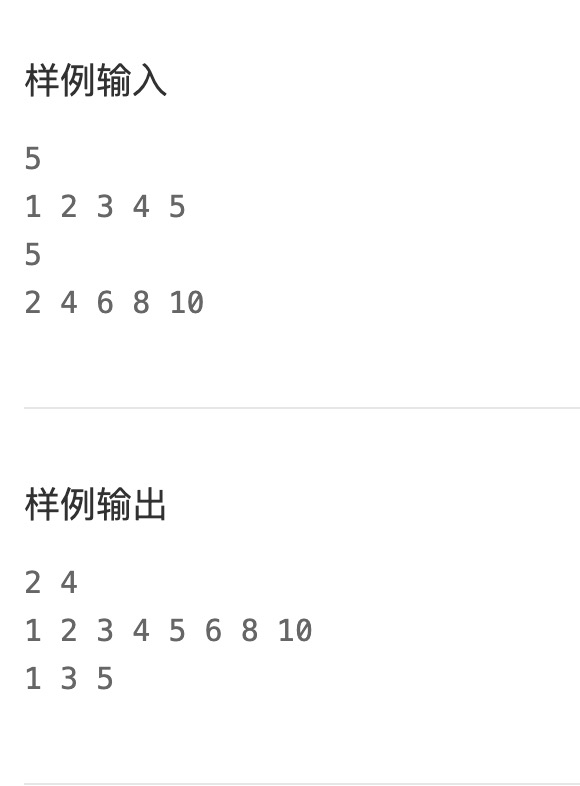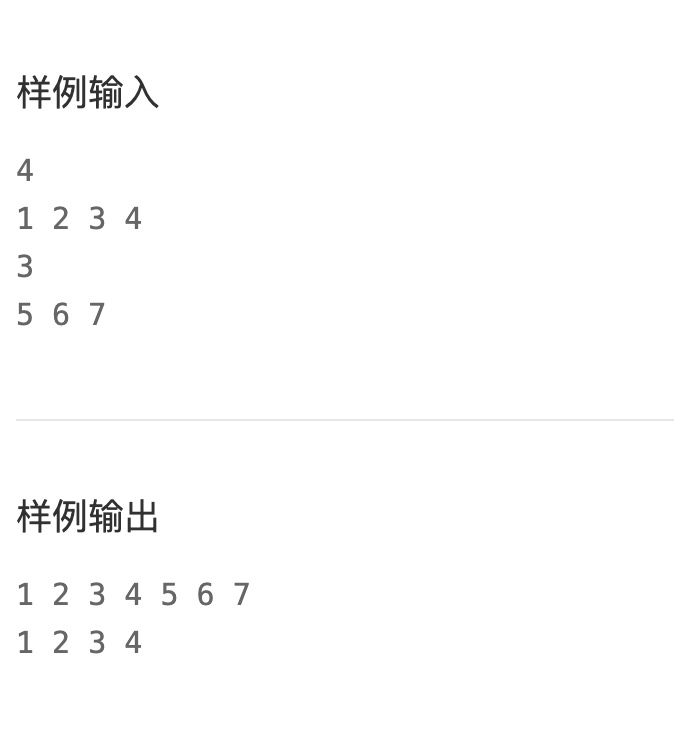集合运算



解析: 根据交集、并集和余集的特性,封装了三个方法分别进行处理。因为交集、并集和余集中的数字个数都是不确定的,所以用集合ArrayList接收数据比较适合,再将集合转变成数组,对数组进行升序处理就得到了最终的结果。
package _4_9_test;
import java.lang.reflect.Array;
import java.util.ArrayList;
import java.util.Arrays;
import java.util.Scanner;
import java.util.concurrent.locks.ReentrantLock;
/* 集合运算
* B在A中的余集,A中除去A和B相交元素的所有元素
* */
public class NightyThree {
public static void main(String[] args) {
// TODO Auto-generated method stub
Scanner scanner = new Scanner(System.in);
// 得到两个输入的数组
int n = scanner.nextInt();
int A[] = new int[n];
for (int i = 0; i < n; i++) {
A[i] = scanner.nextInt();
}
int m = scanner.nextInt();
int B[] = new int[m];
for (int i = 0; i < m; i++) {
B[i] = scanner.nextInt();
}
// 调用三个方法,返回三个集合的结果
Object jiaoji[] = jiao(A, B);
Object bingji[] = bing(A, B);
Object yuji[] = yu(A, B);
// 输出三个集合的结果
for (Object i : jiaoji) {
System.out.print(i + " ");
}
System.out.println();
for (Object i : bingji) {
System.out.print(i + " ");
}
System.out.println();
for (Object i : yuji) {
System.out.print(i + " ");
}
}
// 交集
public static Object[] jiao(int a[], int b[]) {
ArrayList<Integer> arrayList = new ArrayList<>();
// 如果两个数组中有相同的数,就添加到集合中
for (int i = 0; i < a.length; i++) {
for (int j = 0; j < b.length; j++) {
if (a[i] == b[j]) {
arrayList.add(a[i]);
}
}
}
// 将集合转成数组
Object[] result = new Object[arrayList.size()];
result = arrayList.toArray();
// 对数组进行升序排序
Arrays.sort(result);
return result;
}
// 并集
public static Object[] bing(int a[], int b[]) {
ArrayList<Integer> arrayList = new ArrayList<Integer>();
// 先将第一个数组中有,第二个数组中没有的数字添加进集合中。
// 再将第二个数组中所有的数字添加进集合中
for (int i = 0; i < a.length; i++) {
boolean flag = true;
for (int j = 0; j < b.length; j++) {
if (a[i] == b[j]) {
flag = false;
break;
}
}
if (flag) {
arrayList.add(a[i]);
}
}
for (int i = 0; i < b.length; i++) {
arrayList.add(b[i]);
}
Object[] result = new Object[arrayList.size()];
result = arrayList.toArray();
Arrays.sort(result);
return result;
}
// 余集
public static Object[] yu(int a[], int b[]) {
ArrayList<Integer> arrayList = new ArrayList<Integer>();
// 将第一个数组中有,第二个数组中没有的数字添加进集合中。
for (int i = 0; i < a.length; i++) {
boolean flag = true;
for (int j = 0; j < b.length; j++) {
if (a[i] == b[j]) {
flag = false;
}
}
if (flag) {
arrayList.add(a[i]);
}
}
Object[] result = new Object[arrayList.size()];
result = arrayList.toArray();
Arrays.sort(result);
return result;
}
}
本文作者:西红柿里没有番茄
本文链接:https://www.cnblogs.com/lyd447113735/p/12733742.html
版权声明:本作品采用知识共享署名-非商业性使用-禁止演绎 2.5 中国大陆许可协议进行许可。





【推荐】编程新体验,更懂你的AI,立即体验豆包MarsCode编程助手
【推荐】凌霞软件回馈社区,博客园 & 1Panel & Halo 联合会员上线
【推荐】抖音旗下AI助手豆包,你的智能百科全书,全免费不限次数
【推荐】博客园社区专享云产品让利特惠,阿里云新客6.5折上折
【推荐】轻量又高性能的 SSH 工具 IShell:AI 加持,快人一步
· DeepSeek 解答了困扰我五年的技术问题
· 为什么说在企业级应用开发中,后端往往是效率杀手?
· 用 C# 插值字符串处理器写一个 sscanf
· Java 中堆内存和栈内存上的数据分布和特点
· 开发中对象命名的一点思考
· DeepSeek 解答了困扰我五年的技术问题。时代确实变了!
· PPT革命!DeepSeek+Kimi=N小时工作5分钟完成?
· What?废柴, 还在本地部署DeepSeek吗?Are you kidding?
· 赶AI大潮:在VSCode中使用DeepSeek及近百种模型的极简方法
· DeepSeek企业级部署实战指南:从服务器选型到Dify私有化落地